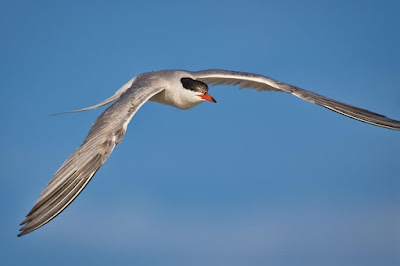 |
| photo by Tom Hanna |
LEAST TERNS (LETE) – We have Least Terns chicks everywhere and several have decided to leave the posting to go to the water…including very little ones. If you see a chick making its way to the water, just walk with it and allow it to go to the water. One of our beach stewards was on the beach yesterday afternoon and experienced this first hand. The fuzzy chick walked to the water, got a drink and splashed and then walked back to the posting.
Parent birds are spending the day feeding and protecting their MANY chicks from the heat and potential predators.
 |
| photo by Tom Hanna |
 |
| photo by Tom Hanna |
COMMON TERNS (COTE) – Common Tern chicks and fledglings can be seen throughout the posting and on the beach. The parent birds are encouraging the COTE fledglings to fly over the inlet.
 |
| photo by Tom Hanna |
 |
| photo by Tom Hanna |
 |
| photo by Tom Hanna |
We also discovered two new Common Tern nests so little chicks are visible from the Masonboro Inlet side of the posting.
BLACK SKIMMERS (BLSK) – A group of biologists met again this week at sunrise to band more Black Skimmer chicks. Capturing and banding non-flying Black Skimmer chicks takes place in phases as the chicks grow.
We have a second wave of nesting as about 30 pairs of Black Skimmers continue in incubate nests close to the posting.
 |
| photo by Tom Hanna |
Black Skimmer chicks can be seen throughout the posting and are getting good size. We are seeing juvenile BLSK flying over the inlet and practicing skimming skills this week. A total of 26 Black Skimmer fledglings were recently counted at the water’s edge and “skimming school” has begun!
 |
| photo by Tom Hanna |
AMERICAN OYSTERCATCHERS (AMOY) – We are sadden to report that our injured Oystercatcher chick has not been seen for several days…which has been expected.
The good news is that the second chick banded ETX aka “Tex” is doing great! The fact that we have a chick from this nesting developing so well after both of its parents sustained injuries and later one parent died is remarkable. The good news is that Tex is reaching a really good size and will develop even faster now that the parent bird is feeding it exclusively. Tex was seen this week taking a little flight on the beach. You will see Tex, the Oystercatcher chick, unsupervised on the beach during low tide and it is “street/beach smart” running into the posting as vehicles or people approach.








No comments:
Post a Comment